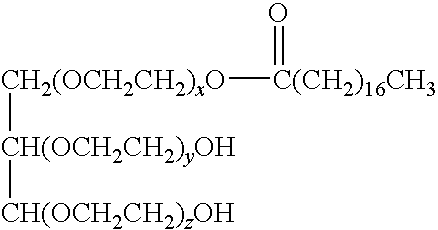Cosmetic Composition Comprising A Combination of a Sugar Fatty Acid Ester with a Plant Extract of Waltheria Indica or Pisum Sativum for Skin Whitening
a technology of waltheria indica or pisum sativum and cosmetic composition, which is applied in the field of skin whitening cosmetic compositions, can solve the problems of safety, stability, smell or efficacy of these whitening agents that do not meet consumer needs, and the skin whitening activity that can be achieved in standard cosmetic formulations is limited, and the use of fatty acid esters is limited
- Summary
- Abstract
- Description
- Claims
- Application Information
AI Technical Summary
Problems solved by technology
Method used
Image
Examples
example 1
Extract of Waltheria indica
[0155]1.2 kg Waltheria indica leaves were added to 20 litres of distilled water, then heated to 85-90° C. and stirred for 2 hours. The extract was then cooled to room temperature and centrifuged for 15 min at 3500 g. The brown extract obtained was then hydrolysed for 4 hours at 60° C. with papain, a proteinase from papayas. The enzyme was deactivated by heat shock at 90° C. The extract was then cooled to room temperature, and after addition of PVP (polyvinyl pyrrolidone), was separated from the residue by filtration through depth filters with a mean porosity of 200 to 400 nm (from Seitz, Bordeaux, France), an extract with a dry residue of 1.2% by weight was obtained. The extract was spray-dried at a starting temperature of 185° C. and an end temperature of 80° C., after the addition of mannitol as an auxiliary in the proportion of 10:90 by weight respectively for the extracted material: mannitol.
[0156]The same treatment produced an extract of a dry residu...
example 2
Extract of Waltheria indica
[0157]1.2 kg Waltheria indica leaves were added to 5.5 litres of distilled water and 13.2 kg pentylene glycol heated to 85-90° C. and stirred for 2 hours. The extract was then cooled to room temperature and centrifuged for 15 min at 3500 g. The brown extract was separated from the residue by filtration through depth filters with a mean porosity of 200 to 400 nm (from Seitz, Bordeaux, France), an extract with a dry residue of 1.7% by weight obtained.
example 3a
Extract of Waltheria indica
[0158]2 kg Waltheria indica leaves were percolated for 2 hours with 30 litres distilled water heated to 90° C. The extract thus obtained was cooled to room temperature and, after addition of PVP (polyvinyl pyrrolidone), was separated from the residue by filtration through depth filters with a mean porosity of 200 to 400 nm (from Seitz, Bordeaux, France), an extract with a dry residue of 0.5% by weight being obtained. The same treatment produced a dry residue of 0.5 to 5% by weight depending on the starting material. The extract was spray-dried at a starting temperature of 185° C. and an end temperature of 80° C., optionally after the addition of an auxiliary, such as mannitol (1 / 2 auxiliary, 1 / 2 extracted material or 1 / 10 auxiliary and 9 / 10 extracted material).
PUM
 Login to View More
Login to View More Abstract
Description
Claims
Application Information
 Login to View More
Login to View More - R&D
- Intellectual Property
- Life Sciences
- Materials
- Tech Scout
- Unparalleled Data Quality
- Higher Quality Content
- 60% Fewer Hallucinations
Browse by: Latest US Patents, China's latest patents, Technical Efficacy Thesaurus, Application Domain, Technology Topic, Popular Technical Reports.
© 2025 PatSnap. All rights reserved.Legal|Privacy policy|Modern Slavery Act Transparency Statement|Sitemap|About US| Contact US: help@patsnap.com


